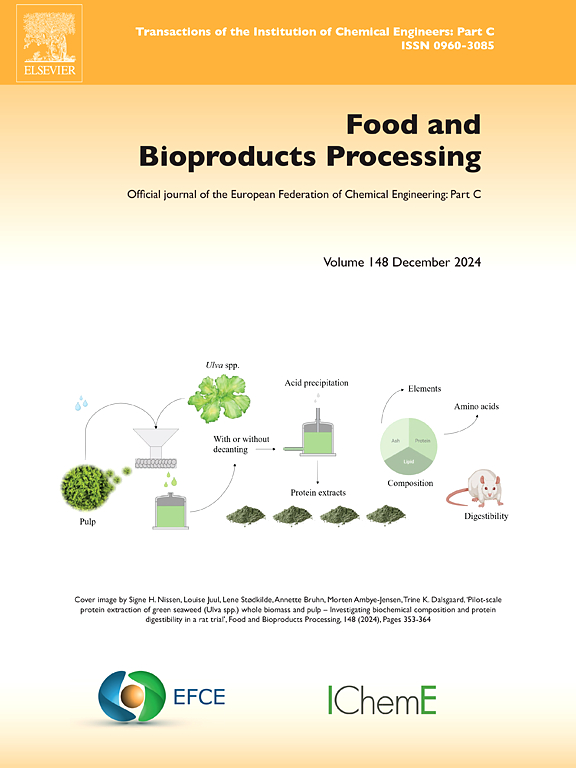空间交叉污染概况:水回用对家禽加工过程中弯曲杆菌和大肠杆菌动态的影响
IF 3.4
2区 农林科学
Q2 BIOTECHNOLOGY & APPLIED MICROBIOLOGY
引用次数: 0
摘要
为了限制过度用水,大多数现代家禽养殖场循环利用水,促进共享水环境中的流动动力学,这与均匀混合假设不相容。然而,在这样的处理阶段,典型的量化微生物动力学的建模工具依赖于同质性,无法捕捉空间变化。为了解决这个问题,我们最近开发了第一个反应-扩散-平流模型,跟踪了浸泡冷却过程中微生物动力学的时空演变。虽然我们证明了模型的完备性和适用性,但还需要更详细的模型验证和关键参数值的确定。在目前的工作中,我们确定了弯曲杆菌和大肠杆菌在工业环境中的动力学参数分布。为了验证模型,我们使用了来自不同商业冷水机运行的冷冻前胴体分布作为输入,由此模型预测冷冻后弯曲杆菌水平的95% % CI为(3.05,4.05)Log 10 CFU·胴体−1,包含观察到的平均值3.33 Log 10 CFU·胴体−1。同样,对于大肠杆菌污染,该模型预测为(3.4,3.6)Log 10 CFU·屠体−1,而观察到的平均值为3.53 Log 10 CFU·屠体−1。我们进行了详细的参数研究,说明了沿冷却器水箱交叉污染的不同高风险和低风险区域。考虑到瞬态动力学,该模型预测了这些区域在典型的8-h加工移位期间的演变。模型输出还表明,增加的水逆流和再循环速率促进了冷却后细菌负荷的更大减少,从而提高了胴体生产线的速度。本文章由计算机程序翻译,如有差异,请以英文原文为准。
Spatial cross-contamination profiles: Effect of water reuse on dynamics of Campylobacter and E. coli during poultry processing
To limit excessive water usage, most modern poultry operations recycle water, promoting flow dynamics in shared water environments that are incompatible with uniform mixing assumptions. However, typical modeling tools quantifying microbial dynamics at such processing stages rely on homogeneity and are unable to capture spatial variations. To address this, we recently developed the first reaction-diffusion-advection model tracking spatial and temporal evolution of microbial dynamics during the immersion chilling process. While we demonstrated well-posedness and applicability of the model, more detailed model validation and key parameter value determination were needed. In the present work, we determined parameter distributions for Campylobacter and E. coli dynamics in an industrial setting. For model validation, we used pre-chill carcass distributions from different commercial chiller operations as inputs, from which the model predicted a 95 % CI of (3.05, 4.05) Log 10 CFU·carcass−1 for post-chill Campylobacter levels, containing the observed mean of 3.33 Log 10 CFU·carcass−1. Similarly, for E. coli contamination, the model predicted (3.4, 3.6) Log 10 CFU·carcass−1, compared with the observed mean of 3.53 Log 10 CFU·carcass−1. We conducted a detailed parameter study, illustrating distinct high and low risk zones for cross-contamination along the chiller tank. Considering transient dynamics, the model predicted the evolution of these zones during a typical 8-h processing shift. Model outputs also indicated that increased water counterflow and recirculation rates foster greater reduction on post-chill bacteria loads for faster carcass line speeds.
求助全文
通过发布文献求助,成功后即可免费获取论文全文。
去求助
来源期刊

Food and Bioproducts Processing
工程技术-工程:化工
CiteScore
9.70
自引率
4.30%
发文量
115
审稿时长
24 days
期刊介绍:
Official Journal of the European Federation of Chemical Engineering:
Part C
FBP aims to be the principal international journal for publication of high quality, original papers in the branches of engineering and science dedicated to the safe processing of biological products. It is the only journal to exploit the synergy between biotechnology, bioprocessing and food engineering.
Papers showing how research results can be used in engineering design, and accounts of experimental or theoretical research work bringing new perspectives to established principles, highlighting unsolved problems or indicating directions for future research, are particularly welcome. Contributions that deal with new developments in equipment or processes and that can be given quantitative expression are encouraged. The journal is especially interested in papers that extend the boundaries of food and bioproducts processing.
The journal has a strong emphasis on the interface between engineering and food or bioproducts. Papers that are not likely to be published are those:
• Primarily concerned with food formulation
• That use experimental design techniques to obtain response surfaces but gain little insight from them
• That are empirical and ignore established mechanistic models, e.g., empirical drying curves
• That are primarily concerned about sensory evaluation and colour
• Concern the extraction, encapsulation and/or antioxidant activity of a specific biological material without providing insight that could be applied to a similar but different material,
• Containing only chemical analyses of biological materials.
 求助内容:
求助内容: 应助结果提醒方式:
应助结果提醒方式:


